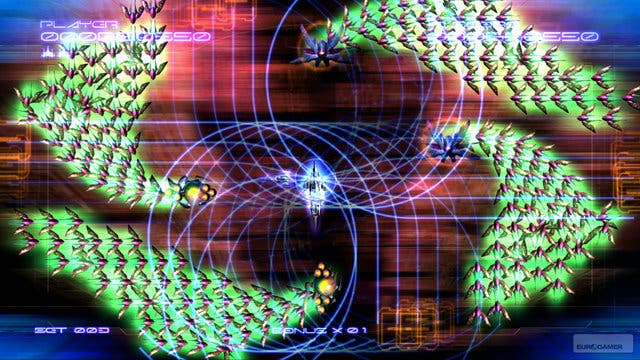Galaga Legions
Loving the alien.
This mechanic alone is ingenious enough, and rejuvenates the static shoot-'em-up template admirably. It adds just the right amount of tactical muscle, forcing you to react with brain as well as fingers, without slowing things down. Quite the opposite, in fact, since Galaga Legions soon reaches speeds that will leave less able players punch-drunk and gasping for breath. The screen soon fills up, packed with lines for waves yet to arrive, swarms of enemies already in play, your lasers and their swooping cast-offs as well as scores and bonus multipliers popping up. When you're in the zone, it all comes together and makes perfect sense. Lose focus, however, and the game punishes you harshly.
But there are still more elements added to the mix. Legion Attacks are activated by destroying the floating plasma balls that drift into play at predetermined points in each area. This creates a vortex that sucks in all undefeated enemies, and deposits up to 16 of them behind you, ready to fight on your behalf. This boosts your firepower massively, and as the captured Galagans are split between your ship and your satellites, cunning placement can create inescapable crossfire capable of wiping out even the most daunting enemy wave. These Galagan drones are impervious to attack, but can be destroyed through contact with their former friends. Manoeuvring and redeploying your remote units to retain as many Galagans as possible adds yet another wrinkle to the gameplay. It almost feels like a lightning-fast RTS game at times.
Certain waves of enemies are connected to a core ship, and destroying this wipes out the whole wave. Often, there's no way to survive other than to target these as quickly as possible - though they usually hide in the middle of giant swarms, or attack in numbers at the heads of swirling lines of enemies. Progress becomes a question of trial and error, memorising attack patterns and finding the perfect spot from which to take down each new attack wave. Once you start to do this, and can clear wave after wave through precise satellite placement rather than painstakingly chipping away at each tiny ship, the sense of achievement is immense.

Make no mistake though, Galaga Legions is not for the faint of heart. There's an auto-fire option, which makes the game marginally easier, and you can use the score-chasing Championship Mode to play any of the five areas, but if you're not hooked by the first, you're unlikely to be won over by anything that follows. It's a game that knows its audience will be dedicated leaderboard addicts, and everything is structured with them in mind. There's even a replay option for the true perfectionists, allowing you to watch your last game over and see where mistakes were made or points were missed. It's just a shame there's no slow motion.
Toppling Geometry Wars 2 from its throne is now the goal for any stripped-down Live Arcade shooter, and Namco Bandai deserves praise for delivering a game that comes within grasping distance of this lofty aim. That Galaga Legions arrives only a few weeks after Geometry Wars 2 hopefully won't count against it, with players left destitute by the buffet of quality titles over the last month. The two games actually go very well together, similar in focus and approach but varied enough to scratch distinctly different shoot-'em-up itches. It's really only the comparative lack of variety that keeps Galaga Legions from bettering its rival, and even that won't be a hindrance to dedicated shmup addicts. If you've still got MS Points to spare, it's yet another compelling purchase.








